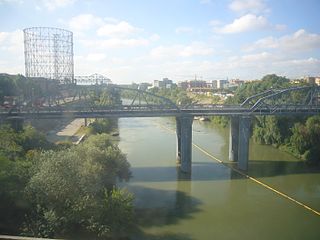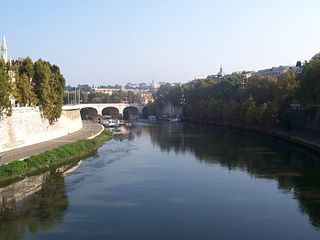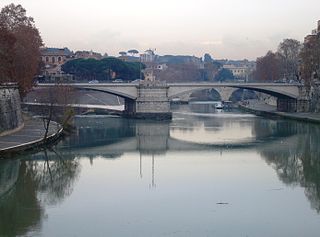
Lungotevere delle Navi is the stretch of lungotevere linking Ponte Giacomo Matteotti to Piazzale delle Belle Arti in Rome, in the Flaminio district. [1]

Lungotevere is an alley or boulevard running along the river Tiber within the city of Rome. The building of the Lungoteveres required the demolition of the former edifices along the river banks and the construction of retaining walls called muraglioni.

Ponte Giacomo Matteotti, formerly Ponte del Littorio, is a bridge that links Lungotevere Arnaldo da Brescia to Piazza delle Cinque Giornate in Rome (Italy), in the Rione Prati and in the Flaminio and Della Vittoria quarters.

Rome is the capital city and a special comune of Italy. Rome also serves as the capital of the Lazio region. With 2,872,800 residents in 1,285 km2 (496.1 sq mi), it is also the country's most populated comune. It is the fourth most populous city in the European Union by population within city limits. It is the centre of the Metropolitan City of Rome, which has a population of 4,355,725 residents, thus making it the most populous metropolitan city in Italy. Rome is located in the central-western portion of the Italian Peninsula, within Lazio (Latium), along the shores of the Tiber. The Vatican City is an independent country inside the city boundaries of Rome, the only existing example of a country within a city: for this reason Rome has been often defined as capital of two states.
The lungotevere is named after the Italian Navy, whose ministry is located in the avenue; it was established by resolution of the Governor of 7 May 1928. [2]

The Italian Navy is the Navy of the Italian Republic. It is one of the four branches of Italian Armed Forces and was formed in 1946 from what remained of the Regia Marina after World War II. As of August 2014, the Italian Navy had a strength of 30,923 active personnel with approximately 184 vessels in service, including minor auxiliary vessels. It is considered a multiregional and a blue-water navy.
The palazzo della Marina, set of the Ministry offices, was built between 1924 and 1928 and designed by Giulio Magni in 1914. Of Neo-Baroque style, the façade features two anchors that mark the entrance, which belonged to the Austrian battleships Viribus Unitis and Tegetthoff, sunken on 1 November 1918 in Pula.

The Baroque Revival, also known as Neo-Baroque, was an architectural style of the late 19th century. The term is used to describe architecture which displays important aspects of Baroque style, but is not of the Baroque period proper—i.e., the 17th and 18th centuries. Elements of the Baroque architectural tradition were an essential part of the curriculum of the École des Beaux-Arts in Paris, the pre-eminent school of architecture in the second half of the 19th century, and are integral to the Beaux-Arts architecture it engendered both in France and abroad. An ebullient sense of European imperialism encouraged an official architecture to reflect it in Britain and France, and in Germany and Italy the Baroque revival expressed pride in the new power of the unified state.
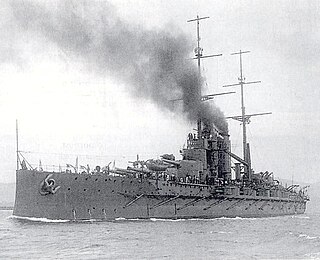
SMS Viribus Unitis was an Austro-Hungarian dreadnought battleship, the first of the Tegetthoff class. "Viribus Unitis", meaning "With United Forces", was the personal motto of Emperor Franz Joseph I.

SMS Tegetthoff was the second of four Tegetthoff-class dreadnought battleships built for the Austro-Hungarian Navy. Tegetthoff was named for the 19th-century Austrian Admiral Wilhelm von Tegetthoff, most notable for defeating the Italian Regia Marina at the Battle of Lissa in 1866. the ship was armed with a main battery of twelve 30.5 cm (12.0 in) guns in four triple turrets. Constructed shortly before World War I, she was built at the Stabilimento Tecnico Triestino shipyard in Trieste, where she was laid down in September 1910 and launched in March 1912.
In correspondence of Lungotevere delle Navi, between Ponte Matteotti and Ponte Risorgimento, is located an "Urban Oasis of the Tiber", in custody to WWF since 1989. [3]
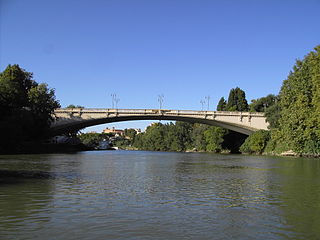
Ponte del Risorgimento is a bridge that links Piazzale delle Belle Arti to Piazza Monte Grappa in Rome (Italy), in the Flaminio and Della Vittoria quarters.
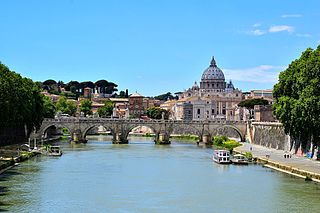
The Tiber is the third-longest river in Italy, rising in the Apennine Mountains in Emilia-Romagna and flowing 406 kilometres (252 mi) through Tuscany, Umbria and Lazio, where it is joined by the river Aniene, to the Tyrrhenian Sea, between Ostia and Fiumicino. It drains a basin estimated at 17,375 square kilometres (6,709 sq mi). The river has achieved lasting fame as the main watercourse of the city of Rome, founded on its eastern banks.

The World Wide Fund for Nature (WWF) is an international non-governmental organization founded in 1961, working in the field of the wilderness preservation, and the reduction of human impact on the environment. It was formerly named the World Wildlife Fund, which remains its official name in Canada and the United States.










